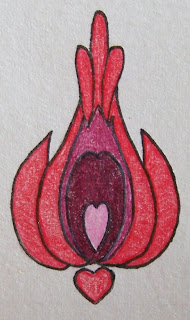Cifraszűr need to be described... These were felt "overcoats", which Hungarian shepherds wore. They were made of felt, and were quite warm (including in the summer, although they weren't unbearably hot). The interesting thing about them, is the embroidery. These were embroidered with wool, not cotton or linen thread. They were also only embroidered by men, the "szűrszabó", which were formed into 'guilds' in the main centres of production. And, as the cifraszűr was found in many different areas of Hungary, while the overall form was the same, with few differences (the sleeves would be long, which was the main type, or they would be short, "stubby" things sown shut with a "plug", and used as pockets. These last forms were more common west of the Tisza river). They would be richly decorated; the back panel, hanging from the shoulders would often be richly decorated, and have rosettes at the corners. The lapels on the front would be decorated, and often stretched to the bottom edge, which would itself be decorated, as would the seam at the back, and the waistline. They were also "closed" with a buckle at chest-height. One of my favourite articles of Hungarian clothing, which I would dearly love to acquire an example of! (Unfortunately, I have been unable to find a usable picture of a cifraszűr. But it's easily Googleable.)

One of the first things I had to do with this project was actually dye the paper. Yes, good old-fashioned tea-dyeing, to give it the look of white felt, which, of course, wasn't "printer-paper white". This had the side-effect of curling the paper, since I had a short time in which to dye it, let it dry, and trace the design, before I left for a visit to Québec City. Thankfully, as a result of storing it in a portfolio, it's now lying quite flat. The colours were an interesting discovery. So far, I'd been able to get away with using plain colours, without having to blend (I definitely don't have an art background...), but the colour scheme for this one was red, pink, and... dark and light "Bordeaux" (which is in itself a dark red). Which meant I had to discover the secret to blending colours. In this case, I think I succeeded quite well.
What surprised me, was the amount of red involved. How red it was. Of course, the colour scheme showed where the red would be, but I've yet to be able to visualize the colours on a blank design. The pink and bordeauxs softened much of the initial shock as to how red it was, but I recall wondering whether I'd made a smart choice in design. And since I was using watercolour pencils for the first time, I didn't realize that they would rub, and I ended up with a nice red glow around the design itself. Which was for the most part subsequently erased, after having shifted my hand and arm position for the remaining colours (touch the paper as little as possible!).

The greeting was another problem. Since this was a birthday card, it had to have the appropriate greetings of goodwill, happiness, etc., etc., but I didn't want something along the lines of "all the stars are dancing for you, because an angel told me it was your birthday". Sometimes I'd think I found one, and then later reread it, and decide against it. Finally, one said (get ready, this will be a horrible translation) "I wish the days of your life will be like the surf of a clear brook". It sounds better in Hungarian.
Early on, I had decided to use a Gothic script for this one (it seemed more "manly" than most of the other scripts I'd used to this point. But certain types of Gothic can be quite difficult to read when written in large amounts, since the excellence of Gothic isn't judged by the individual letter or word, but rather by the appearance of the entire sheet. If the page looks even, equal, nothing standing out, it looks like it was "woven", it's a good example. If there are "holes", or if something stands out, it loses its cohesion. One of my books had an example of Gothic with "spiked" foot serifs, which lent weight to the script. Combining this with my script, it kept it readable, but also accentuated the letters themselves, without taking away from the overall appearance.
He was well pleased. Enough said.

Aucun commentaire:
Enregistrer un commentaire